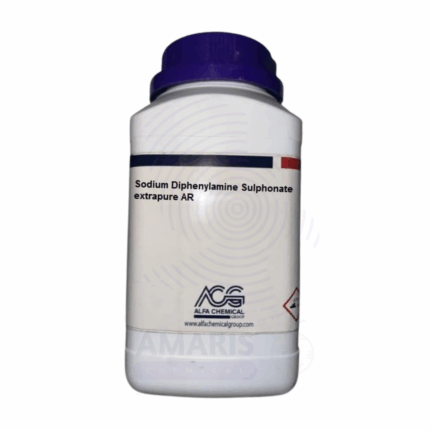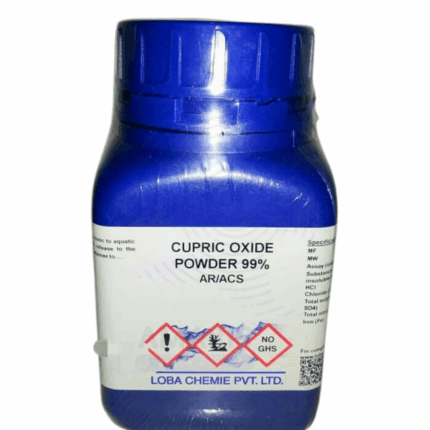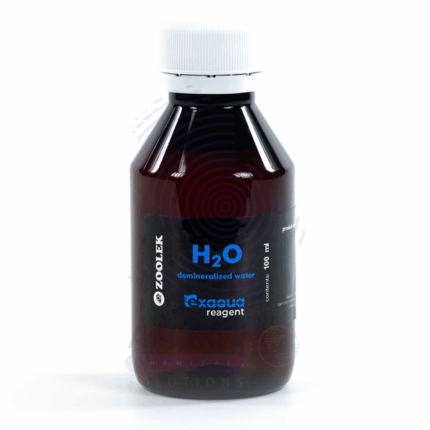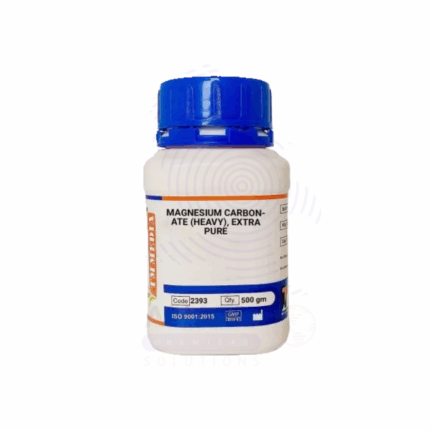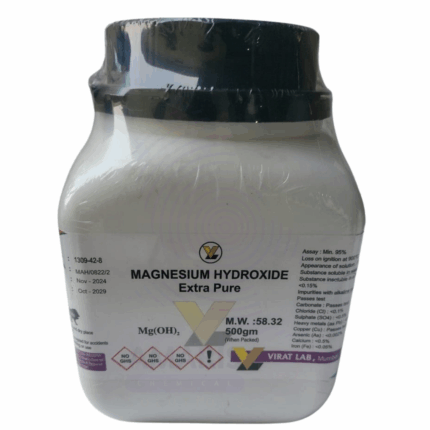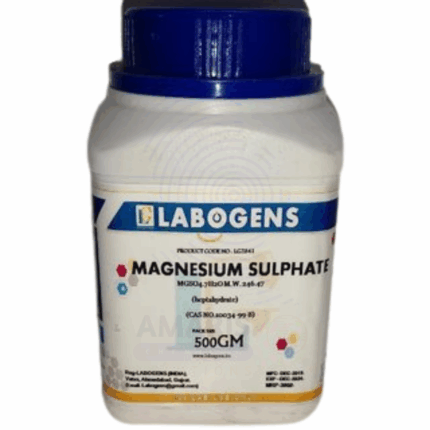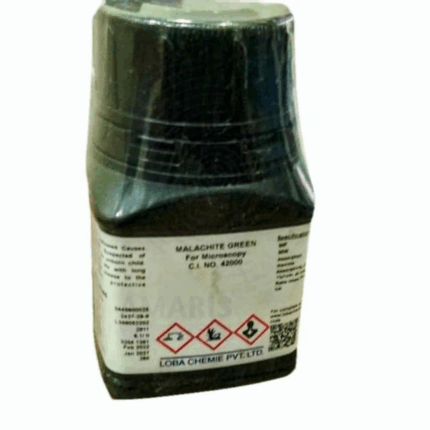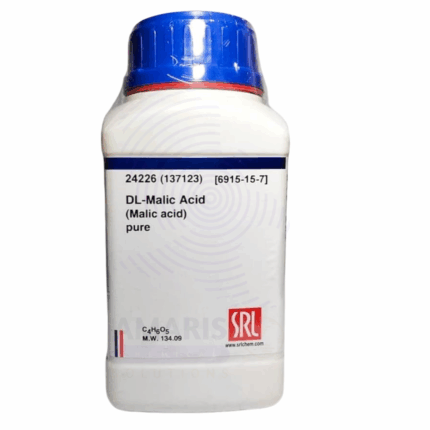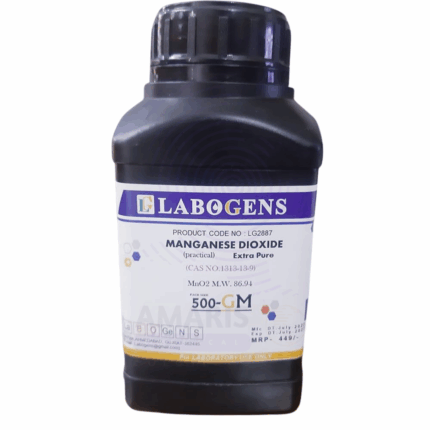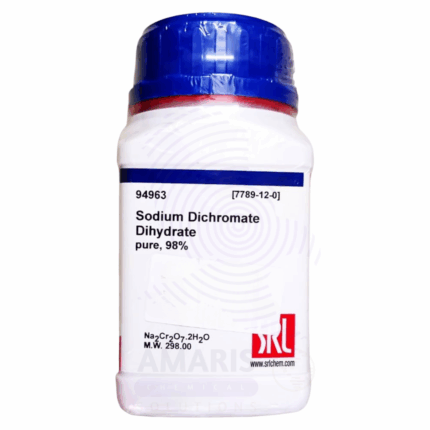
Sodium Dihydrogen Phosphate Extra Pure
$ 19.20
Sodium Dihydrogen Phosphate Extra Pure is a white, water-soluble crystalline compound commonly used as a buffering agent in analytical and biochemical applications. It offers precise pH control in phosphate buffer systems, making it ideal for lab-scale titrations, enzyme reactions, and chromatography. Due to its high solubility and consistent purity, it is also widely used in pharmaceutical formulations, food processing (as E339), and electrolyte replacement therapies. Its Extra Pure grade ensures reliability in sensitive chemical and biological procedures.
Sodium Dihydrogen Phosphate Extra Pure
PRIMARY USES
- Analytical Reagent & Laboratory Applications:
Used as a buffering agent in analytical chemistry and biochemistry
• Applied in the preparation of phosphate buffer solutions with controlled pH
• Helps stabilize enzyme activity in biochemical assays
• Involved in titrations, electrophoresis, and chromatography applications - Pharmaceutical & Medical Formulations:
Serves as a laxative or urinary acidifier in some medicinal products
• Functions as an excipient and buffering agent in injectable solutions
• Included in electrolyte replacement preparations and dialysis fluids - Food & Beverage Industry (regulated use):
Acts as a pH stabilizer and acidity regulator (E339) in food processing
• Used in cheese making and meat curing to improve texture and moisture retention
• Prevents precipitation of metal ions in soft drinks and beverages
SECONDARY USES
- Water Treatment:
Functions as a corrosion inhibitor and metal ion sequestrant in water systems
• Adjusts water alkalinity and aids in pH stabilization of treated water - Textile & Dyeing Industry:
Employed as a buffering salt during dyeing processes
• Enhances color fastness by controlling pH during fabric treatment - Agricultural & Soil Applications:
Used as a source of phosphorus in specialty nutrient solutions for hydroponics and fertigation
1. Basic Identification Attributes
- Chemical Name: Sodium Dihydrogen Phosphate
• CAS Number: 7558-80-7
• HS Code: 2835.12.00
• Molecular Formula: NaH₂PO₄
• Synonyms:
- Monosodium phosphate
- Sodium phosphate monobasic
- Monobasic sodium phosphate
- MSP
2. Physical & Chemical Properties
Physical State: Solid (crystalline powder or granules)
• Color & Odor: White, odorless
• Melting Point: ~60 °C (dihydrate), decomposes at higher temperatures
• Density/Specific Gravity: ~2.04 g/cm³
• Solubility:
- Highly soluble in water (~85 g/100 mL at 20 °C)
- Insoluble in alcohol
• pH Level: ~4.5 to 5.5 (1% aqueous solution)
• Vapor Pressure & Volatility: Non-volatile
• Flash Point: Not applicable (non-flammable)
3. Safety & Hazard Attributes
Hazard Class (GHS Classification):
- Not classified as hazardous under normal use
• NFPA Ratings: - Health: 1
- Flammability: 0
- Reactivity: 0
• Exposure Limits: - No established OSHA PEL or ACGIH TLV
• Reactivity: - Stable under normal conditions
- May react with strong oxidizers
4. Storage & Handling Attributes
Storage Conditions:
- Store in a cool, dry, and well-ventilated place
- Keep container tightly closed to avoid moisture absorption
• Incompatible Materials: - Strong acids, strong bases, oxidizing agents
• Container Type: - HDPE, polyethylene-lined drums, or sealed containers
• Shelf Life & Expiration Date: - Stable for several years if stored properly
• Special Handling Requirements: - Avoid generating dust
- Use appropriate PPE when handling in bulk
5. Regulatory & Compliance Attributes
Regulatory Status:
- GRAS (Generally Recognized As Safe) by the FDA for food use
- Approved under USP and FCC for pharmaceutical and food applications
• Transportation Restrictions: - Not classified as hazardous for transport
• Waste Disposal Method: - Dispose according to local environmental regulations
- Non-hazardous waste classification
6. Environmental & Health Impact
Ecotoxicity:
- Low toxicity to aquatic life
• Persistence in Environment: - Phosphates may contribute to eutrophication in large quantities
• Carcinogenicity/Mutagenicity: - Not classified as carcinogenic or mutagenic
• Biodegradability: - Inorganic compound; not biodegradable but readily assimilated in biological systems
SAFETY PRECAUTIONS
Personal Protective Equipment (PPE):
• Use chemical-resistant gloves (e.g., nitrile)
• Wear safety goggles or protective eyewear
• Use a lab coat or appropriate protective clothing
• Use dust mask if handling powder in bulk
Handling:
• Avoid inhalation of dust
• Wash hands thoroughly after handling
• Use with adequate ventilation
Storage:
• Store in sealed containers away from moisture and incompatible substances
• Keep in a dry, cool location
FIRST AID MEASURES
Inhalation:
• Move to fresh air
• Seek medical attention if breathing difficulty occurs
Skin Contact:
• Wash skin with soap and water
• Remove contaminated clothing
Eye Contact:
• Rinse with water for at least 15 minutes
• Seek medical advice if irritation persists
Ingestion:
• Rinse mouth with water
• Do not induce vomiting
• Seek medical attention if large quantities are ingested
FIRE FIGHTING MEASURES
Flammability:
• Not flammable
Extinguishing Media:
• Use appropriate media for surrounding fire (water, foam, dry chemical, CO₂)
Hazardous Combustion Products:
• May produce sodium oxides or phosphorus oxides if heated to decomposition
Firefighter Protection:
• Use full protective gear and SCBA in case of fire


 Preservatives(food)
Preservatives(food) Flavor Enhancers
Flavor Enhancers Acidulants
Acidulants Sweeteners
Sweeteners Antioxidants
Antioxidants Colorants(food)
Colorants(food) Nutraceutical Ingredients (food)
Nutraceutical Ingredients (food) Nutrient Supplements
Nutrient Supplements Emulsifiers
Emulsifiers
 Collectors
Collectors Dust Suppressants
Dust Suppressants Explosives and Blasting Agents
Explosives and Blasting Agents Flocculants and Coagulants
Flocculants and Coagulants Frothers
Frothers Leaching Agents
Leaching Agents pH Modifiers
pH Modifiers Precious Metal Extraction Agents
Precious Metal Extraction Agents
 Antioxidants(plastic)
Antioxidants(plastic) Colorants (Pigments, Dyes)
Colorants (Pigments, Dyes) Fillers and Reinforcements
Fillers and Reinforcements Flame Retardants
Flame Retardants Monomers
Monomers Plasticizers
Plasticizers Polymerization Initiators
Polymerization Initiators Stabilizers (UV, Heat)
Stabilizers (UV, Heat)
 Antifoaming Agents
Antifoaming Agents Chelating Agents
Chelating Agents Coagulants and Flocculants
Coagulants and Flocculants Corrosion Inhibitors
Corrosion Inhibitors Disinfectants and Biocides
Disinfectants and Biocides Oxidizing Agents
Oxidizing Agents pH Adjusters
pH Adjusters Scale Inhibitors( water)
Scale Inhibitors( water)
 Antioxidants(cosmetic)
Antioxidants(cosmetic) Emollients
Emollients Fragrances and Essential Oils
Fragrances and Essential Oils Humectants
Humectants Preservatives
Preservatives Surfactants(cosmetic)
Surfactants(cosmetic) Thickeners
Thickeners UV Filters
UV Filters
 Fertilizers
Fertilizers Soil Conditioners
Soil Conditioners Plant Growth Regulators
Plant Growth Regulators Animal Feed Additives
Animal Feed Additives Biostimulants
Biostimulants Pesticides (Herbicides, Insecticides, Fungicides)
Pesticides (Herbicides, Insecticides, Fungicides)
 Active Pharmaceutical Ingredients (APIs)
Active Pharmaceutical Ingredients (APIs) Excipients
Excipients Solvents(pharmaceutical)
Solvents(pharmaceutical) Antibiotics
Antibiotics Antiseptics and Disinfectants
Antiseptics and Disinfectants Vaccine Adjuvants
Vaccine Adjuvants Nutraceutical Ingredients (pharmaceutical)
Nutraceutical Ingredients (pharmaceutical) Analgesics & Antipyretics
Analgesics & Antipyretics
 Analytical Reagents
Analytical Reagents Solvents(lab)
Solvents(lab) Chromatography Chemicals
Chromatography Chemicals Spectroscopy Reagents
Spectroscopy Reagents microbiology-and-cell-culture-reagents
microbiology-and-cell-culture-reagents Molecular Biology Reagents
Molecular Biology Reagents Biochemical Reagents
Biochemical Reagents Inorganic and Organic Standards
Inorganic and Organic Standards Laboratory Safety Chemicals
Laboratory Safety Chemicals Specialty Laboratory Chemicals(Special Laboratory Equipment)
Specialty Laboratory Chemicals(Special Laboratory Equipment)
 Demulsifiers
Demulsifiers Hydraulic Fracturing Fluids
Hydraulic Fracturing Fluids Scale Inhibitors(oil)
Scale Inhibitors(oil) Surfactants(oil)
Surfactants(oil) Drilling Fluids
Drilling Fluids
 Dyes and Pigments
Dyes and Pigments Bleaching Agents
Bleaching Agents Softening Agents
Softening Agents Finishing Agents
Finishing Agents Antistatic Agents
Antistatic Agents
 Admixtures
Admixtures Waterproofing Agents
Waterproofing Agents Sealants and Adhesives
Sealants and Adhesives Curing Compounds
Curing Compounds Concrete Repair Chemicals
Concrete Repair Chemicals Anti-Corrosion Coatings
Anti-Corrosion Coatings
 Surfactants(cleaning)
Surfactants(cleaning) Builders
Builders Enzymes
Enzymes Solvents (Cleaning)
Solvents (Cleaning) Fragrances
Fragrances
 Electronic Chemicals
Electronic Chemicals Catalysts
Catalysts Lubricants
Lubricants Photographic Chemicals
Photographic Chemicals Refrigerants
Refrigerants Automotive chemicals
Automotive chemicals Pyrotechnic Chemicals
Pyrotechnic Chemicals
 Biodegradable Surfactants
Biodegradable Surfactants Bio-based Solvents
Bio-based Solvents Renewable Polymers
Renewable Polymers Carbon Capture Chemicals
Carbon Capture Chemicals Wastewater Treatment Chemicals
Wastewater Treatment Chemicals
 Pigments
Pigments Solvents(paint)
Solvents(paint) Specialty Coatings
Specialty Coatings Binders/Resins
Binders/Resins Additives
Additives Driers
Driers Anti-Corrosion Agents
Anti-Corrosion Agents Functional Coatings
Functional Coatings Application-Specific Coatings
Application-Specific Coatings
 Fresh Herbs
Fresh Herbs Ground Spices
Ground Spices Whole Spices
Whole Spices Spice Blends
Spice Blends Dried Herbs
Dried Herbs
 Leavening Agents
Leavening Agents Dough Conditioners
Dough Conditioners Flour Treatments
Flour Treatments Fat Replacers
Fat Replacers Decoratives
Decoratives Preservatives(baking)
Preservatives(baking)
 Plasticizers & Softeners
Plasticizers & Softeners Reinforcing Agents
Reinforcing Agents Adhesion Promoters
Adhesion Promoters Vulcanizing Agents
Vulcanizing Agents Antidegradants
Antidegradants Blowing Agents
Blowing Agents Fillers & Extenders
Fillers & Extenders Accelerators & Retarders
Accelerators & Retarders
